A structural adhesive is used to bond a joint and hold two or more substrates together under stress. They have found their way into various industries with constantly evolving adhesive technology.
For example, adhesives are a valid joining alternative in some applications that improves product quality, such as high-pressure tanks and critical structural components for vehicles, buildings, and civil engineering structures.
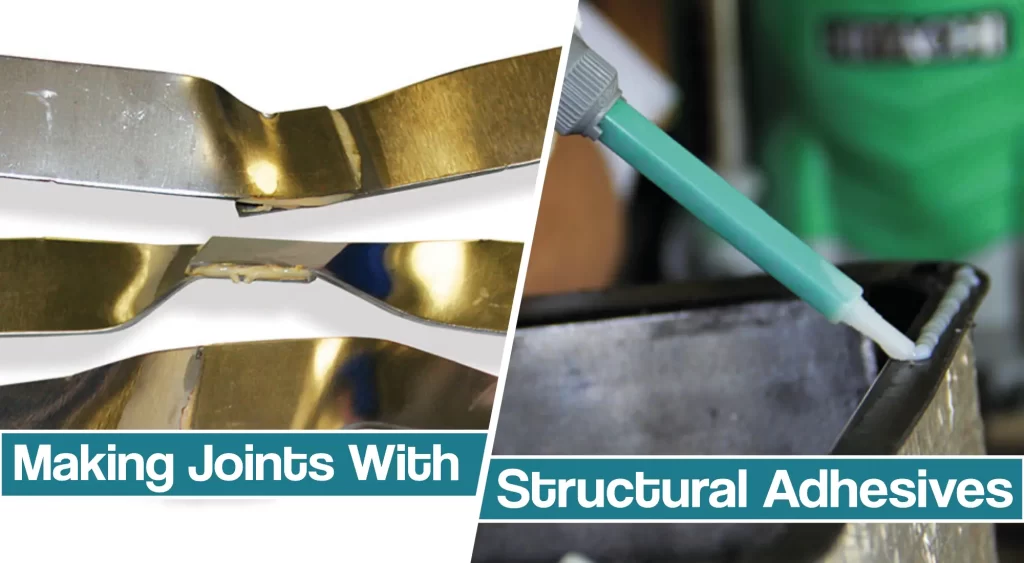
However, many consider that the research is still to be done to achieve the same results regarding the strength or heat resistance of welding or other metal fasteners.
Nonetheless, let’s take a look at structural adhesives and where they thrive.
What Are Structural Adhesives?
Most structures are composed of many individual parts or components which have to be connected to create a system.
Therefore, structural adhesive bonding represents one of the most enabling technologies to fabricate various complex structural configurations for load-bearing applications.
Structural adhesives can spread or transfer loads over the bonded area. Therefore, the uniform distribution of stress is better than spot welds and mechanical fasteners.
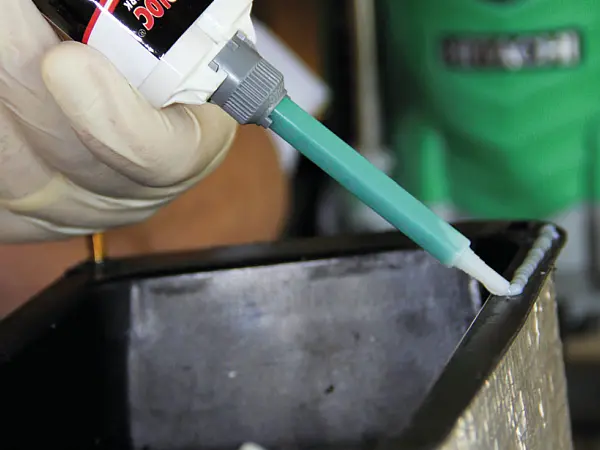
Adhesives offer lower material costs per application than mechanical fasteners. In addition, the labor cost is lower compared to welding and threaded fasteners.
One of the significant advantages is joining dissimilar materials and materials with different thicknesses. Therefore you can use them to bond metal to plastic or different metal grades.
Types of Structural Adhesives
Structural adhesives are obtainable in three primary chemistries: epoxies, urethanes, and acrylics. Each type has its advantages and drawbacks, which we will explain.
| Property | Epoxies | Acrylic | Urethanes |
|---|---|---|---|
| Overlap shear - metal | Good | Fair to good | Fair to good |
| Overlap shear - plastics | Fair | Good | Good |
| Shear - oily materials | Poor | Good | Poor |
| Peel strength | Good | Poor | Poor |
| Impact resistance and toughness | Poor to good | Poor to fair | Poor |
| Flexibility | Poor to good | Poor | Poor |
| Temperature resistance | Good | Fair | Poor to fair |
| Solvent resistance | Good | Poor | Poor to fair |
Epoxy Adhesives
Epoxy adhesives provide the highest shear strength on various metals, composites, thermoplastics, glass, and natural substrates such as wood. Today, you can find single-component and two-component epoxy adhesives.
Single component epoxy adhesives have the highest tensile strength, often 5100-6000 PSI. They provide excellent resistance to chemicals and temperatures, which can resist up to 400°F.
However, the high thermal resistance can make it difficult to de-bond. To soften the parts, you will need to heat them above 480°F.
Two-component epoxy adhesives provide 2900-4400 psi tensile strength. However, they adhere well to many more substrates and cure at room temperature. That’s why they perform exceedingly well on composites and plastic.
As a rule of thumb, epoxies match adhesion to metals. On the contrary, Acrylics provide better adhesion to plastics.
Acrylic Adhesives
Acrylic and methyl methacrylate structural adhesives also have very high tensile strength, approximately 4000 psi. In addition, they bond well to metals and plastics. Generally, acrylics have high impact strength with good shear, peel strength, and fatigue resistance.
To de-bond, the cured acrylic adhesive must be heated above 390°F. However, the most significant advantage is they can successfully bond to metals and composites with little to no surface preparation.
Urethane Adhesives
Urethanes are known for high shear and peel strength. However, their most significant benefit is flexibility. They are often used in marine and automotive industries because of their excellent adhesion properties for sheet molding composites and flexibility.
Polyurethanes provide good adhesion to wood, plastic, and primed or painted metals. However, to bond metals, you will need to use primers. Nonetheless, they provide a faster set time and the best bonding for composites.
Joint Design for Structural Adhesives
Besides a number of different factors that affect the use of structural adhesives, joints must be specifically designed. For example, joints should be planned so that primary stress is shear or tensile, and cleavage and peel should be minimized. Thus, bonded areas should share the load equally.
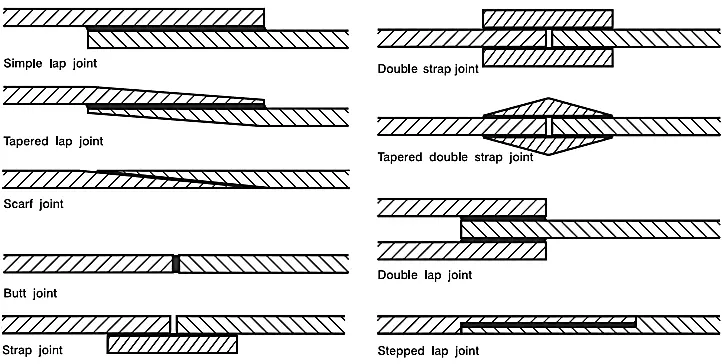
Among many different designs, several joints are recommended. Lap joints are most common and valuable in bonding thin metals. Among lap joints, widely used methods are simple lap joint, joggle lap, tapered single lap, double butt lap, and double scarf lap joints.
Angle joints give rise to either peel or cleavage stress depending on the gauge metal. In addition, landed scarf tongue and groove, conventional tongue and groove, and scarf tongue and groove can be used with adhesives.
Structural Adhesive Applications
Due to their positive characteristics, structural adhesives found applications in many industries. Transportation, aerospace, automotive, marine, and construction are just a few of them we can highlight.
So, let’s look at how adhesive thrives in various applications.
Adhesives in Transportation
The transportation manufacturing industry is among the first that adopt adhesives, and there are several reasons.
A reduction of overall weight is one of the critical goals of the transportation industry. A drop in the weight of a ship or plane impacts fuel consumption, which eventually reduces transportation costs. Since adhesives provide excellent bonding strength with low weight, they are essential in lightweight designs.
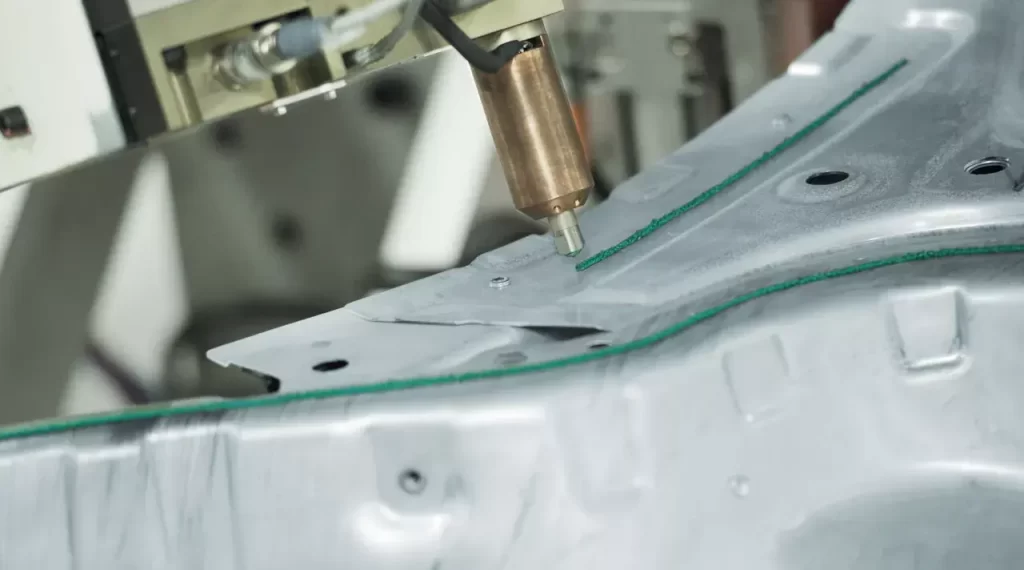
In addition, adhesives can cut manufacturing costs by reducing the number of mechanical fasteners, spot welds, and filler metal. To understand how adhesive changed the transportation industry, we will give some examples.
One of the noticeable improvements that adhesives brought into transportation is reducing manufacturing time. For example, the manufacturers of all-aluminum beverage trucks eliminated the rivets and plastic rails that used to cover them by introducing adhesives. As a result, the overall manufacturing time for the rear exterior walls of the truck bodies was reduced by about 25%.
In addition, attaching the bolts requires two operators, while one person can apply adhesives, position the bar on the wall and tack it. As a result, the overall time of the installation process has been reduced by 20% with adhesives.
Experts in the automotive industry explain that mid-sized cars consist of up to 5000 welds. By introducing adhesives, they expect to reduce the number by half.
Reducing the number of welded points can also reduce the overall weight of the car by 55 lbs, while the rigidity of the body remains the same or higher. However, a vital problem is a resistance to fracture under loads for widely ranging temperatures.
The technology is yet to perfect adhesives that could perform in various weather conditions, from dry arid climate or cold mountains of the US.
Structural Adhesives in Marine Industry
Adhesive bonding of joints in the marine environment is increasingly gaining popularity. However, although adhesive in shipbuilding offers economical, performance-related, and environmental advantages over traditional welding in some applications, the concept is not as widely spread as in the automotive industry.
Shipbuilders in the US have used adhesives in non-load-bearing applications, and there are various evaluations and feedback.
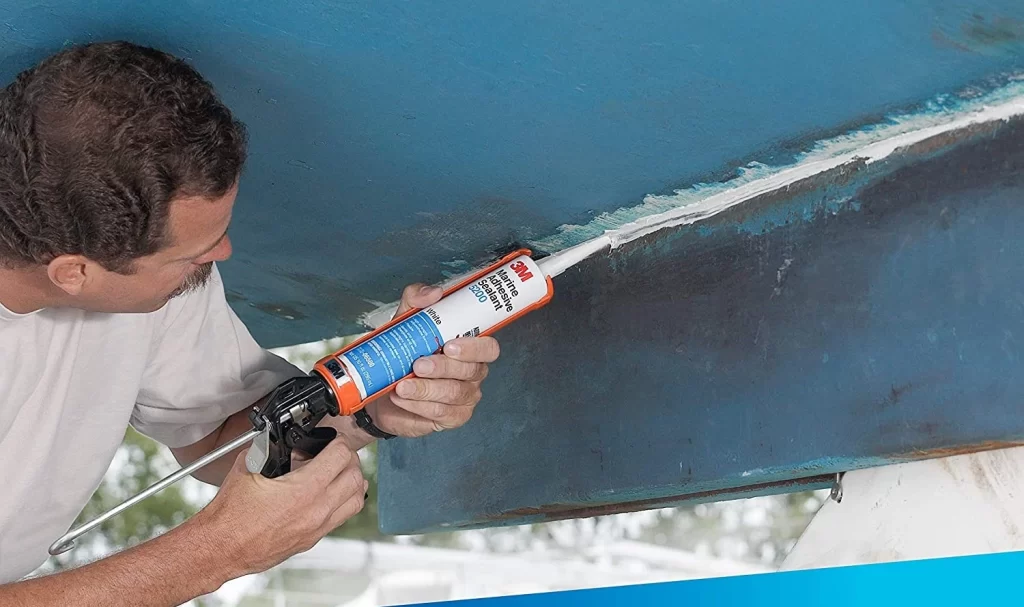
For example, the published documents state that adhesives in fastening support, stiffeners, and other attachments in outfitting passenger ships could reduce costs up to 20%.
The biggest concerns are again related to the thermal resistance of the adhesives. Experts fear that intense fire can interfere with the integrity of adhesive joints in ships.
Structural Adhesives in Construction
Structural adhesives in construction can reduce the time and materials to build particular objects. For example, a four ft. by four ft. shear wall that meets the Seismic Zone 4 requires about 45 minutes of assembly time and approximately 300 collated screws.
On the contrary, the entire construction with adhesives and 75 pneumatic pins takes about 5 minutes. So the overall construction time is reduced by 85%.
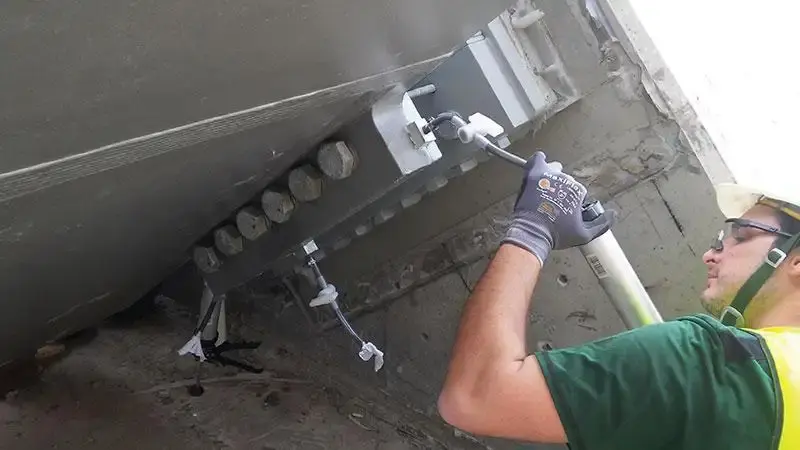
However, despite technological advances, adhesives still lose their strength over time. That’s why the benefit of adhesives for metal-to-metal bonding in civil engineering projects has been widely discussed.
Many experts discourage using adhesives when projects have a design life of 100 years. Yet, that’s where welding, screws, bolts, and rivets thrive as well-established joining technologies.
On the other hand, certain two-component, heat-curing epoxy adhesives were effective in boding exterior metal gas distribution pipes. The pipes proved to be leakproof after 30-50 years of service.
Advantages and Drawbacks of Structural Adhesives
Advantages
- They spread or transfer loads over the bonded area, making a more uniform stress distribution.
- They reduce the weight of the structures they are used.
- They increase the stiffness of structures and fatigue resistance while providing reduced noise and vibration transference.
- They can join dissimilar materials and variable thicknesses of materials.
- They maintain the integrity of the bonded material.
- They can reduce the overall time required for assembly and construction.
Disadvantages
- They provide lower strength when compared with welding or other joining methods.
- They usually lack peel strength for loads.
- Limited resistance to heat
- Surface pre-treatment prior to application is required
- They require a particular joint design
- They lose potency over time
Final Thoughts
Structural adhesives, without a doubt, offer some significant advantages that many industries recognize and apply. That’s why adhesives are widely used in transportation and somewhat popular in the shipbuilding and construction industries.
However, despite the good, they also have bad sides. That’s why many consider adhesives are yet to be perfected so they can replace standard bonding methods such as welding, bolting, or riveting.
With today’s technological advancement, scientists may even succeed.
Resources:
- https://www.twi-global.com/technical-knowledge/faqs/faq-what-is-a-structural-adhesive
- https://www.permabond.com/resource-center/strongest-adhesive/
- https://www.sciencedirect.com/topics/engineering/adhesive-joints
- https://www.intechopen.com/chapters/59097
- https://www.applicheminc.com/blog/adhesive-strength-test-terms





